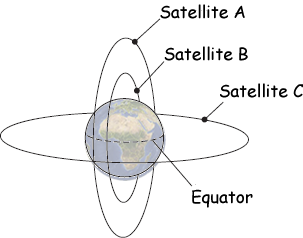GCSE level questions on the Earth in Space
Q4.
(a) The following diagram shows three satellites, A, B and C, in orbit around the Earth. The diagram is not to scale.

(i) Complete the following table. Each letter may be used once, more than once or not at all.
| Description of satellite |
Is this satellite A, B or C? |
| It is in a low polar orbit. |
B  |
| It is in a geostationary orbit. |
C  |
| It is used as a monitoring satellite. |
B  |
(3 marks)
(ii) How long does a satellite in a geostationary orbit take to complete one orbit? (1 mark)
24 hours 
(b) A rocket is used to carry a satellite into position. As the distance between the rocket and the Earth increases, what happens to the the force of gravity between the rocket and the Earth?
A It decreases 
B It stays the same
C It increases
(1 mark)
(c) Satellites cost many millions of pounds to build and to put into orbit. Some people think that this is a waste of money.
(i) Suggest one reason why some people may have this opinion. (1 mark)
They think that the money could be used to help feed people or help with global health problems. They think that satellites do not help humanity. 
(ii) Suggest one reason why other people may disagree with this opinion. (1 mark)
Satellites have dramatically improved communication. This has been beneficial for humanity in sharing information quickly. It has helped business, trade and understanding between people from different countries. It is therefore worth the initial outlay. 
Satellites have improved our knowledge of the Earth, its weather systems and global weather. This has helped mankind understand the science associated with this planet better. 
Satellitles have enabled us to find out more about the Universe. Cloud cover on Earth makes terrestrial telescope pictures inferior to satellite ones. 
(one mark maximum)
(Total 7 marks)


